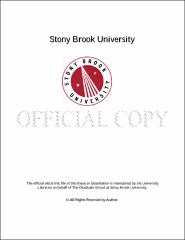| dc.identifier.uri | http://hdl.handle.net/11401/76829 | |
| dc.description.sponsorship | This work is sponsored by the Stony Brook University Graduate School in compliance with the requirements for completion of degree. | en_US |
| dc.format | Monograph | |
| dc.format.medium | Electronic Resource | en_US |
| dc.language.iso | en_US | |
| dc.publisher | The Graduate School, Stony Brook University: Stony Brook, NY. | |
| dc.type | Dissertation | |
| dcterms.abstract | This study of the Universal Negro Improvement Association (UNIA) explains the mobilization successes and failures of a major social movement organization and its leader, Marcus Garvey. The UNIA succeeded in mobilizing millions of Blacks; prior to the UNIA, Black Americans had not developed an organization that produced this level of mobilization. By 1920, Garvey was regarded by both critics and supporters as one of the most important leaders of the African diaspora. This research focuses on the roles of the UNIA’s organizational structure and the Black church in explaining why the UNIA was first highly successful and later collapsed. This study applies Morris’ indigenous perspective, which argues that to best understand a social movement, one must account for extant systems of domination, the nature of the conflict between groups, and the culture of the dominated. I demonstrate that these factors operated in concert to facilitate both the growth and decline of the UNIA. The main findings of the study are that centralization of power, a shift toward a more religious organizational frame, and, the deployment of a network prominent black clergymen were most crucial to the growth of the UNIA. The UNIA’s decline can be explained by a hyper-centralization of power, which included the dismantling of this network of clergymen, and Garvey’s failed attempt at frame bridging. These findings provide important new insight into the mobilization and demobilization process, a central issue in social movement theory. | |
| dcterms.abstract | This study of the Universal Negro Improvement Association (UNIA) explains the mobilization successes and failures of a major social movement organization and its leader, Marcus Garvey. The UNIA succeeded in mobilizing millions of Blacks; prior to the UNIA, Black Americans had not developed an organization that produced this level of mobilization. By 1920, Garvey was regarded by both critics and supporters as one of the most important leaders of the African diaspora. This research focuses on the roles of the UNIA’s organizational structure and the Black church in explaining why the UNIA was first highly successful and later collapsed. This study applies Morris’ indigenous perspective, which argues that to best understand a social movement, one must account for extant systems of domination, the nature of the conflict between groups, and the culture of the dominated. I demonstrate that these factors operated in concert to facilitate both the growth and decline of the UNIA. The main findings of the study are that centralization of power, a shift toward a more religious organizational frame, and, the deployment of a network prominent black clergymen were most crucial to the growth of the UNIA. The UNIA’s decline can be explained by a hyper-centralization of power, which included the dismantling of this network of clergymen, and Garvey’s failed attempt at frame bridging. These findings provide important new insight into the mobilization and demobilization process, a central issue in social movement theory. | |
| dcterms.available | 2017-09-20T16:51:15Z | |
| dcterms.contributor | Goodman, Norman | en_US |
| dcterms.contributor | Schwartz, Michael | en_US |
| dcterms.contributor | Rosenthal, Naomi. | en_US |
| dcterms.contributor | Morris, Aldon | en_US |
| dcterms.creator | Pierce, Kenneth Andrew | |
| dcterms.dateAccepted | 2017-09-20T16:51:15Z | |
| dcterms.dateSubmitted | 2017-09-20T16:51:15Z | |
| dcterms.description | Department of Sociology. | en_US |
| dcterms.extent | 176 pg. | en_US |
| dcterms.format | Monograph | |
| dcterms.format | Application/PDF | en_US |
| dcterms.identifier | http://hdl.handle.net/11401/76829 | |
| dcterms.issued | 2015-12-01 | |
| dcterms.language | en_US | |
| dcterms.provenance | Made available in DSpace on 2017-09-20T16:51:15Z (GMT). No. of bitstreams: 1
Pierce_grad.sunysb_0771E_12437.pdf: 4043231 bytes, checksum: 8126d2777ae286fbd42bf4e99a518ce7 (MD5)
Previous issue date: 1 | en |
| dcterms.publisher | The Graduate School, Stony Brook University: Stony Brook, NY. | |
| dcterms.subject | Charisma, Framing, Garvey, Religion, Resource Mobilization, Social Movements | |
| dcterms.subject | Sociology | |
| dcterms.title | Mobilization Lessons from Marcus Garvey and the Universal Negro Improvement Association | |
| dcterms.type | Dissertation | |

